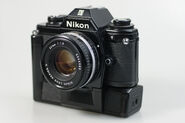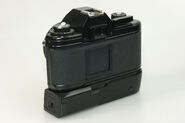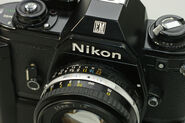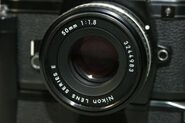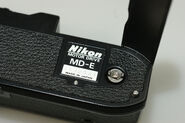Nikon launched the EM in 1979 as the first in a series of 3 low budget compact bodies. Compared to contemporary Nikon cameras, the EM contained a high level of plastic, although it's based on a pretty solid metal internal structure, something which is no longer the case for high end gear nowadays.
The EM was an automatic camera with aperture control. To allow for a higher degree of control, an exposure compensation button was added (front upper right), whereby a 2 steps slower shutter speed was selected to accommodate for the right exposure of backlit subjects. Three mechanical speeds were available in case the battery failed: 1/90 sec, Bulb (long exposures) and 1/1000 sec in the "AUTO" setting.
Together with the EM camera, Nikon launched a set of 8 small, light weight and more affordable lenses. To distinguish from the more professional 'Nikkor' lenses, they were called 'Series E'. However, they feature the same F-mount bayonet and can be used on all AI-spec Nikon cameras. The original version lenses looked pretty cheap, lacked a metal lens mounting ring and had a more rudimentary finish of the focusing and aperture ring.
Nikon would not be Nikon if it didn't foresee system accessories even for their junior camera. Besides lenses (Series E and all other AI Nikkor lenses, except for the most recent G lenses), cases and an eyepiece adapter, a dedicated flashlight and motor drive were offered.
Nikon Motor Drive MD-E for Nikon EM[]
The MD-E motor drive was designed specifically for the Nikon EM. Firing rate is 2 frames per second. The battery chamber holds 6 AAA 1.5V batteries. A very nice accessory for the Nikon EM. Although the noise level is quite high.
Links[]
- Nikon EM on www.collection-appareils.fr by Sylvain Halgand
- Nikon EM picture set by Patrick Verbessem
- Nikon EM instruction manual - English at at M.Butkus' www.orphancameras.com
- Nikon EM Statistic Price Info's at AuctionPriceTracker in English
- Nikon EM Statistic Price Info's at AuctionPriceTracker in German
- Nikon EM Statistic Price Info's at AuctionPriceTracker in Italian
